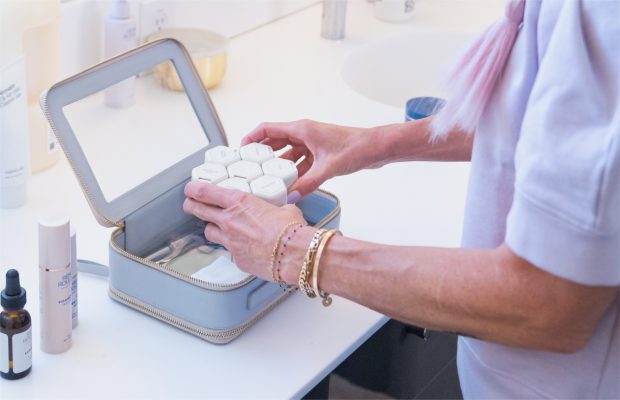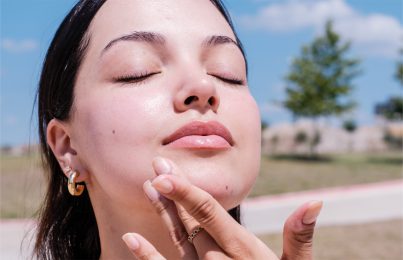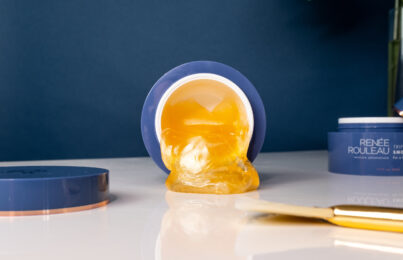Updated 05/11/23. Prepping for a trip can be hectic enough, the last thing you need is to be stressing over which skincare products to pack. Unfortunately, between being on an airplane and then in a brand new environment, travel can sometimes wreak havoc on your skin if you don’t come prepared.
I’ve written this post to help you take the guesswork out of which products to bring on your trip and give you my best skincare travel tips! As someone who’s on a plane almost once a month (if not more!), I’ve gotten pretty good at packing for every scenario.
Stick to the Basics (This Isn’t the Time for Experimentation)
When packing skincare for travel, your number one goal should be to keep your skin as balanced and comfortable as possible. This means it’s definitely not the time to bring along any new skincare products you’ve been wanting to try! The last thing you need is to have a bad reaction, or for your skin to be thrown out of whack at a time when it’s already being introduced to so many new variables.
The first step is to pack your basics (this is especially true if you’re only taking a carry-on and have limited space for liquids). Here are my personal non-negotiable travel skincare products:
- Cleanser
- Daytime moisturizer with SPF
- Nighttime moisturizer
If necessary, decant your products into smaller travel containers (I like to use these ones from Cadence and pack them all together in my Truffle Bag). Even if you’re checking a bag, keep these three products in your carry-on. This way, if your luggage gets lost, you’ll still be able to take care of your skin’s most basic needs.
Pro Tip: I came up with a travel hack years ago that allows me to pack liquid skincare products without actually classifying them as liquids. Start by generously saturating a toning cloth with your favorite alcohol-free toner, eye makeup remover, or other liquid skincare product. Then, store the cloths in a plastic baggie so you can use them as needed.
Choose Your SOS Products Carefully
Your suitcase is precious real estate so if you do bring more skincare products beyond the basics, choose wisely! The two things I would urge you to take into consideration are 1) which problems you’re trying to avoid (i.e. breakouts, sensitivity, or dryness) and 2) the climate you’ll be traveling to (more on this one later).
Everyone: If you only have the luxury of bringing one more skincare product, make it an exfoliant. Don’t get too hung up on what kind, just make sure it’s one you’ve used before and that agrees well with your skin. Removing dry, expired skin cells from your face every few days is a good way to “reset” the skin and can help minimize almost any problem you’re prone to.
If you’re prone to breakouts: consider a hydrating face mask that also fights breakouts with ingredients like salicylic acid or tea tree oil. The reason I love this as an SOS product is that it delivers a 1-2-punch: it minimizes breakout activity on the skin while also providing water-based hydration. Even if you have oily skin, airplane travel or traveling somewhere without much humidity can lead to dehydration (which can lead to more breakouts). With one product, you can stay ahead of both issues.
Additionally, you might want to bring a spot treatment for emergency pimples. If you tend to get cystic acne, bring a non-drying spot treatment. Those more prone to classic whiteheads should opt for something with drying ingredients like benzoyl peroxide or sulfur (this one can even double for calming bug bites!).
If you’re prone to sensitivity: I would recommend either a soothing serum or face mask you can use as often as needed to keep your skin comforted. A few ingredients I personally love for relieving irritation and sensitivity are water lily extract, algae extract (specifically red marine algae), allantoin, and green tea extract.
If you’re prone to dryness: bring a facial oil and/or a lipid-rich moisturizing mask. Replenishing your skin’s oils will be key to preventing flakiness and crepey-looking skin, especially if you’ll be riding on an airplane or are going somewhere cold.
Focus on Skincare Before and After a Flight, Not During
Some people try to prevent the dryness caused by flying on a plane by doing sheet masks or misting their skin mid-flight, but I personally believe this is a waste of time (and that you may end up doing more harm than good). Instead, focus on what you can do for your skin pre- and post-flight.
If you can, do a hydrating mask before your flight then layer up on hydrating ingredients in the form of a toner and serum. Then, lock it all in with a moisturizer. If you’re flying during the day, it’s super important that you choose a moisturizer with SPF. You can get a lot of UV damage being that high up, which is why I always try to get a window seat so I can close the shade. Finally, cap everything off with a few drops of facial oil. This will seal in all that hydration and prevent it from evaporating into the dry, cabin air.
Once you arrive at your destination, wash your face and exfoliate to remove the dry skin cells that built up during the flight. If you can, follow up with a hydrating mask to rehydrate fresh skin cells.
Consider the Climate at Your Destination
Few things can throw your skin off balance as much as heading to a totally different climate than the one you’re used to.
What to Do If You’re Traveling Somewhere Colder and/or Drier
If you have dry skin (Skin Types 7-9): layering rich, oil-based products is essential. You can also consider slugging, which is applying a thin layer of Vaseline or other petrolatum-based product over your moisturizer to create an occlusive seal, just like an oil would. (You also don’t want to neglect your lips, and Vaseline can be great for keeping them from getting chapped.)
If you have oily or combo skin (Skin Types 1-6): keeping your skin hydrated in a cold, dry climate can be a little trickier since you don’t want to layer on too many heavy products. In this case, the best strategy is more layers made up of lighter products. Start by making sure you’re using a cleanser that doesn’t strip the skin. Then, if you can, layer the same way you would before a flight: a hydrating toner, hydrating serum, moisturizer for your skin type, and a facial oil. People are sometimes surprised when I recommend an oil for oily skin types, but it’s all about applying it correctly. The key is gently patting it onto the skin instead of rubbing it in. This will ensure the oil sits on top like a seal to keep everything in instead of settling into your pores.
NOTE: If you’re layering products that contain humectants like glycerin or hyaluronic acid while in a dry environment, be sure to apply them to damp skin then quickly seal them in with moisturizer. Applying humectants to dry skin in a dry environment will give you the opposite of a hydrating effect and leave your skin more dehydrated than before.
What to Do If You’re Traveling Somewhere Warmer and/or More Humid
If you have dry skin (Skin Types 7-9): the good news is you shouldn’t have to switch your routine up much! The humidity may actually do your skin a favor. One thing to keep in mind if you’re going on a beach vacation is that saltwater can dry out the skin. To combat this, I recommend using a water-resistant sunscreen since they use emollients that will help repel water.
If you have oily or combo skin (Skin Types 1-6): you’ll definitely want to focus on oil control to prevent breakouts. One way to do this is to consider switching over to a more acne-focused cleanser; look for something low-foaming that includes ingredients like salicylic acid to curb oil production. Salicylic acid is also a great ingredient to look for in a serum if you bring one since it’s so effective at keeping pores clean. Beyond this, focus on water-based products with a light texture. For nighttime, use either a gel or oil-free lotion moisturizer. For daytime, look for a sunscreen that doubles as a moisturizer to minimize the number of layers on your skin.
I hope you found these tips helpful and that they help you put together the perfect travel skincare routine!
Celebrity Esthetician & Skincare Expert
As an esthetician trained in cosmetic chemistry, Renée Rouleau has spent 30 years researching skin, educating her audience, and building an award-winning line of products. Her hands-on experience as an esthetician and trusted skin care expert has created a real-world solution — products that are formulated for nine different types of skin so your face will get exactly what it needs to look and feel its best. Trusted by celebrities, editors, bloggers, and skincare obsessives around the globe, her vast real-world knowledge and constant research are why Marie Claire calls her “the most passionate skin practitioner we know.”



